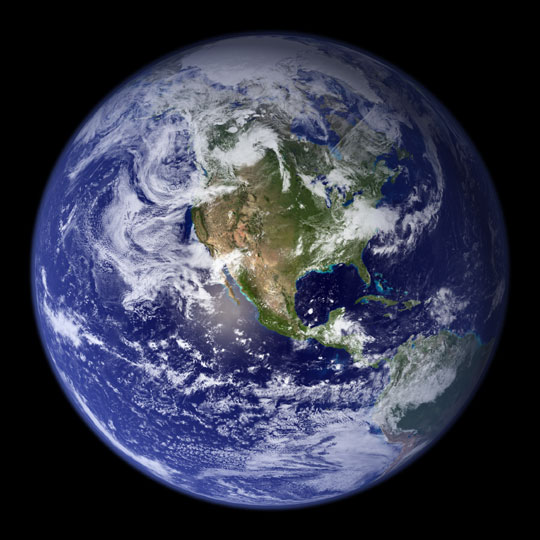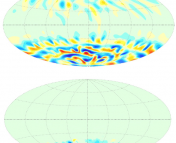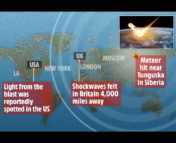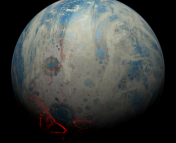Title: Large Impacts onto the Early Earth: Planetary Sterilization and Iron Delivery
Authors: Robert I. Citron, Sarah T. Stewart
First Author’s Institution: Department of Earth and Planetary Science, University of California Davis, Davis, California, USA
Status: full text available on the arXiv. Submitted to the Planetary Science Journal
The early Earth wasn’t your typical Summer break vacation destination. During the Hadean Eon (4.5-4 billion years ago), Earth was an extremely hostile environment and was frequently bombarded by asteroids. Yet, somehow, life on Earth could have emerged during this time.
This story begins with a mildly noteworthy event during the Hadean: a now long-gone planet called Theia, roughly the size of Mars, slammed into the Earth. The massive impact blew off a large amount of debris which started to circle the new Earth-Theia merger and eventually formed the Moon – this proposed sequence of events is known as the Giant Impact Hypothesis (see Figure 1). Theia’s impact melted the Earth’s entire crust several kilometers deep creating an environment not very favorable for any form of life we know of and very likely sterilizing anything already present on Earth. After all the turmoil of the impact settled down, life on Earth, in principle, could have already formed relatively shortly after this, a mere 4.5 billion years ago. Reality, as it turns out, may have run less smoothly.
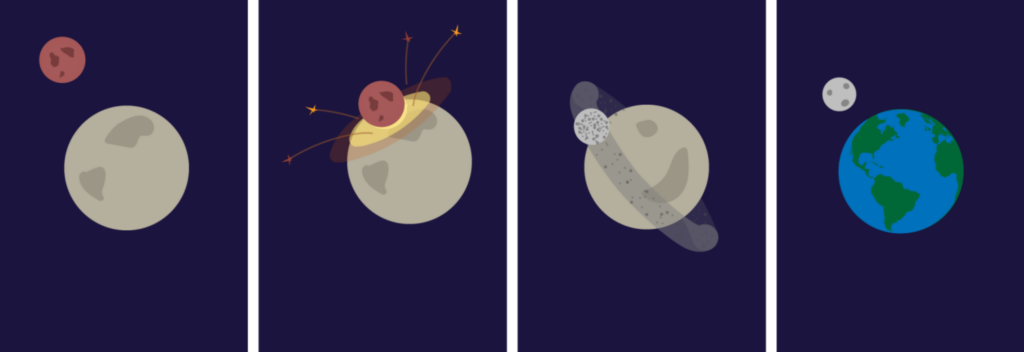
As a deeply studied subject, several hypotheses for the Origin of Life have been proposed. A popular hypothesis states that it all began with the formation of amino acids and RNA molecules. Because our present-day atmosphere and oceans are oxidizing (noticed iron rusting? Maybe some fire?), spontaneously forming these molecules is difficult. But what about all those lifeforms we see today? They needed to come from somewhere. Well, to actually form these amino acids/RNA molecules on a global scale, we would need a reducing atmosphere or ocean. And how better to create one than slamming a huge rock full of reducing material (like iron) into the Earth?
Reducing an atmosphere 101
After the Theia impact, but still during the Hadean, the Earth endured a large amount of impacting asteroids of varying sizes (some may have even been Moon-sized), slingshotted to the inner Solar System by Jupiter and Saturn. The authors of today’s paper wanted to know which objects under which conditions can actually pull it off to create a (temporarily) reducing atmosphere or ocean on Earth, ultimately opening the way to forming the building blocks of life. Instead of really slamming various rocks on Earth, the authors ran Smoothed Particle Hydrodynamics (SPH) simulations of large-sized objects (the projectile) colliding with an Earth-like planet (ominously called the target). To account for several possible scenarios, the authors varied the following parameters in their simulations:
- The object mass, in the order of Lunar masses
- The impact velocity, in the order of Earth’s escape velocity
- The impact angle, where 0° is a head-on impact, see Figure 2
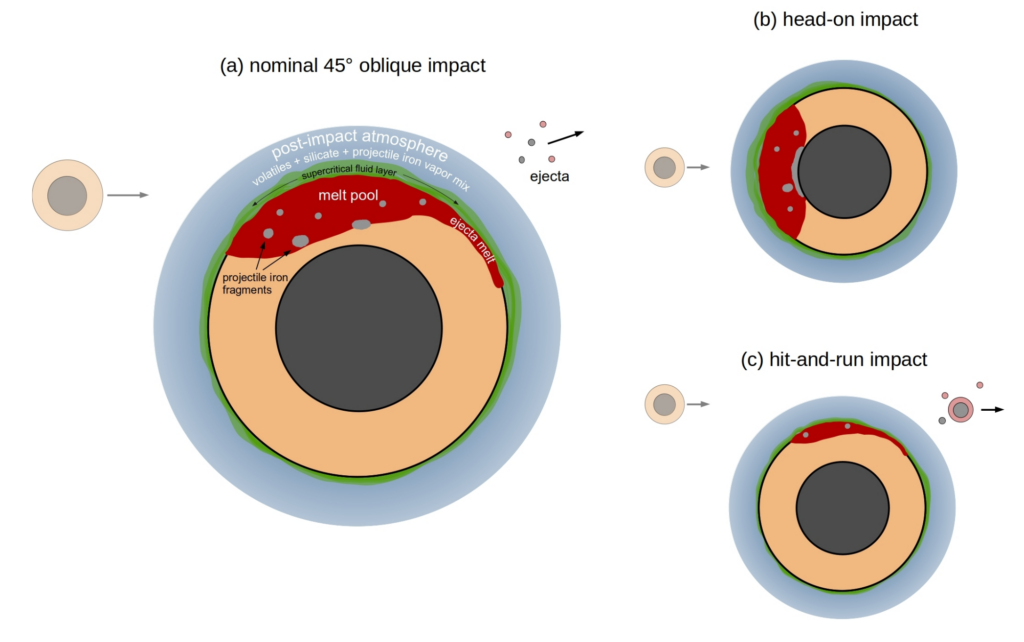
Now, when such an object impacts the Earth, a lot happens in a short span of time. To know what flies off where, the authors kept track of the mantle (made of forsterite) and core (consisting of an iron-silicon alloy) materials of both the simulated impacting object and the Earth. Part of the iron-rich core material – the stuff we need to start large-scale reduction of the Earth’s atmosphere or oceans – gets scattered in the atmosphere by the impact. How much of this iron enters the Earth’s atmosphere depends strongly on how the impact occurred (which is controlled by object mass, impact velocity and impact angle). An example of one of the simulations is shown in Figure 3, where a 24-hour time lapse of the impact is shown.
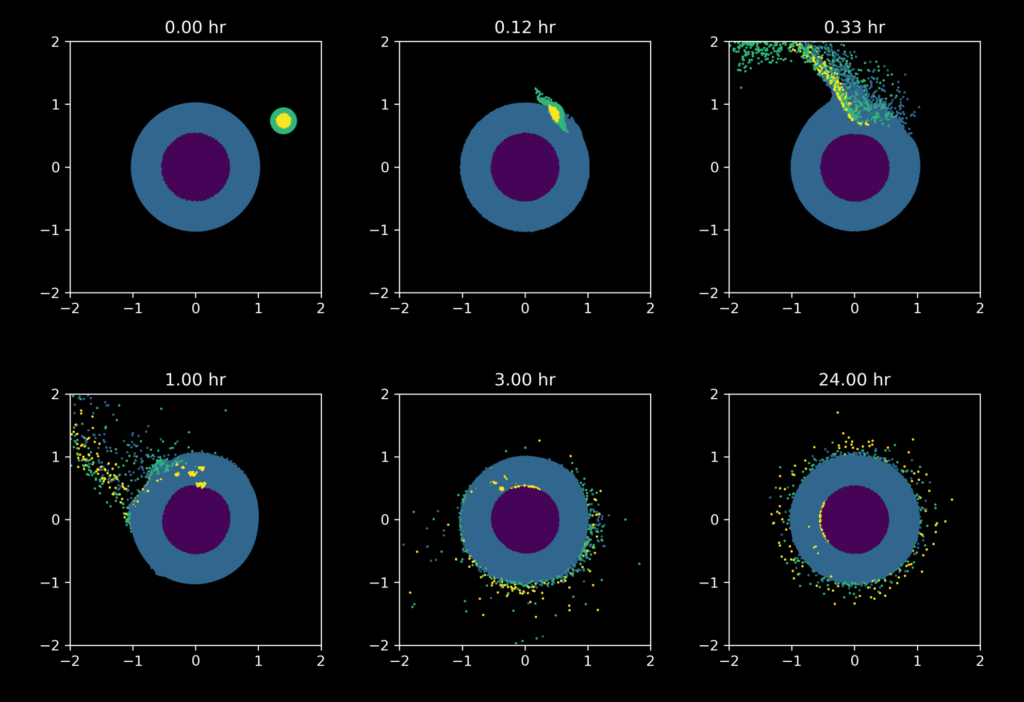
By analyzing their simulations, the authors found that only the largest of the asteroids during the Hadean – the Moon-sized ones – could have delivered enough iron to fully reduce the Earth’s oceans and atmospheres. But there’s an additional problem now. The impact of an object so huge would easily vaporize ocean-sized bodies of water (the authors find that even an object with a radius of 0.2 times the Lunar radius could vaporize the Earth’s early ocean) and would even melt most of the Earth’s surface, creating almost post-Theia impact circumstances which weren’t very life-supporting. Considering all this, it looks like these Hadean asteroids did not really help early life on its way.
However, this study has shown that larger objects than previously estimated would fully sterilize the early Earth’s exterior by melting its whole surface, with a lower limit of 25% of the Lunar mass. As objects this size were rare even during the Hadean, the chances of a mass-extinction by space rocks are lower than previously expected. Even the ocean-evaporating asteroids do not necessarily sterilize the Earth, if early life occurred under the planet’s surface. Moreover, remember the moon-sized asteroids needed to fully reduce the atmosphere and oceans? Turns out we don’t need that kind of overkill (pun intended). Many, much smaller objects slamming into Earth could already reduce the atmosphere or ocean enough to create favorable conditions for spontaneous RNA forming.
In any case, if life emerged from a post-impact world, it would be due to the right asteroids at the right time: too small, and the kick-starter for life wouldn’t occur. Too large, and any progress made so far would be wiped out.
Considering the fact that you are reading this post, it seems our very, very far forebearers weren’t out of luck!
Astrobite edited by Sarah Bodansky.
Featured image credit: adapted from Imgflip

